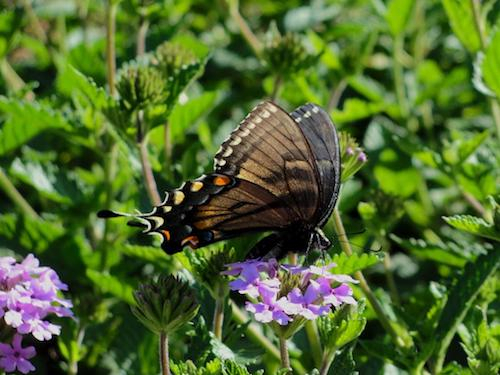
The female black morph of the Eastern tiger swallowtail butterfly nectars on a verbena.
April 24, 2024 - In recent years, there has been a growing awareness of the importance of ecological gardening—a practice that seeks to harmonize human habitation with the natural world. Rather than viewing gardens as isolated patches of flowers, shrubs, and lawns, ecological gardening recognizes them as integral components of larger ecosystems, with the potential to support biodiversity, conserve resources, and promote environmental sustainability.
A cornerstone of ecological gardening is the use of native plants, which are naturally adapted to the local climate, soil conditions, and wildlife. By incorporating native species (those growing in Texas before humans entered the landscape) into your garden, you can create habitats for native pollinators, birds, and other wildlife, while reducing the need for water, pesticides, and fertilizers. From vibrant wildflowers to truly adapted small and large trees, native plants add beauty and diversity to the landscape while supporting the health of local ecosystems.
Water is a precious resource, especially in drought-prone regions like Texas. Ecological gardening emphasizes water conservation through practices such as mulching, rainwater harvesting, and selecting drought-tolerant plants. By minimizing water usage and maximizing efficiency, you can create a garden that thrives while minimizing its environmental impact. Additionally, incorporating water features such as rain gardens and ponds can attract wildlife and enhance the beauty of your outdoor space.
Healthy soil is the foundation of a thriving garden, providing essential nutrients and support for plant growth. Ecological gardening promotes soil health through practices such as composting, mulching, and avoiding chemical pesticides and fertilizers. By nurturing the soil ecosystem and fostering beneficial microorganisms, you can create a resilient and sustainable garden that flourishes year after year.
One of the joys of ecological gardening is the opportunity to create a welcoming habitat for wildlife. By providing food, water, and shelter, you can attract a diverse array of birds, butterflies, bees, and beneficial insects to your garden. Incorporating native plants, creating wildlife-friendly features such as bird feeders, bird baths, and nesting boxes, and minimizing chemical inputs can all contribute to a thriving wildlife habitat in your backyard.
Beyond the practical aspects of gardening, ecological gardening fosters a deeper connection to the natural world. By observing the rhythms of the seasons, paying attention to the needs of plants and wildlife, and practicing mindful stewardship of the land, you can cultivate a greater appreciation for the beauty and complexity of nature. Through gardening, we have the opportunity to become active participants in the ecological community, working in harmony with the land to create a more sustainable and resilient future.
By embracing ecological gardening, we have the power to transform our outdoor spaces into vibrant sanctuaries of biodiversity and beauty. Cultivating native plants, conserving water, nurturing healthy soil, creating wildlife habitat, and fostering ecological awareness, creates gardens that not only enrich our lives but also contribute to the health and resiliency of the planet.
Greg Grant is the Smith County horticulturist and Master Gardener coordinator for the Texas A&M AgriLife Extension Service. He is the author of Texas Fruit and Vegetable Gardening, Texas Home Landscaping, Heirloom Gardening in the South, and The Rose Rustlers. You can read his “Greg’s Ramblings” blog at arborgate.com, read his “In Greg’s Garden” in each issue of Texas Gardener magazine (texasgardener.com), or follow him on Facebook at “Greg Grant Gardens”. More science-based lawn and gardening information from the Texas A&M AgriLife Extension Service can be found at aggieturf.tamu.edu and aggie-horticulture.tamu.edu.








